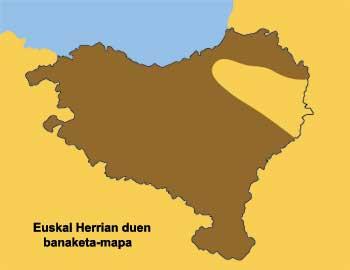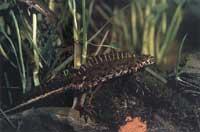Dragon-shaped amphibious marmolaire triton

When talking about amphibians, frogs and toads come to mind most of the time. And no wonder, because their sound songs and their torn appearance are very striking. If we remember that we also have amphibians the tritons, we will often surprise around us, since in most cases people who do not have special fondness for nature do not even know these interesting animals. The exception to this lack of knowledge are, logically, children, who, encouraged by the insatiable curiosity that they wrinkle with maturity, are constantly exploring the environment, since these smooth and lyngid aphids, like the lizard, are often found at the bottom of a muddy water well, in spring.
Among the tritons that can be found in Euskal Herria, the marmolaire triton (Triturus marmoratus) will probably be the most spectacular species. Also the largest, with a total length of approximately 16 cm, with a tail length of 6-7 cm. The marmolaire triton is, on the other hand, an animal of strong appearance, with a disruptive model of coloring with green and black spots on the back and a striking longitudinal orange band that is very curious.
But as with the rest of the tritons, marmolaire triton is not a normally visible animal. Because they are amphibians, their epidermia is not completely waterproof, so during their dry operation they usually present a clear risk of dehydration. To avoid this danger, the marmolaire triton also makes a nightlife, staying during the day under stones or trunks, mosses or any other hiding place. However, this behavior changes radically when spring comes.

Starting in March and in response to the need to reproduce, marmolaire tritons are concentrated in ponds and ponds formed by inert water. And it is at this time that the men of the triton get their most spectacular appearance: as bridal clothing, the testicles appear totally swollen and along the back and tail develop an excellent ridge as dragons of ancient tales.
How much supply and decoration? This is not just a whim: the tritons reproduce with internal fertilization, but as the males have no penises, in order to carry out this internal fertilization they have to perform complex wedding dances. When a male meets another triton, he first knows it with the touch and, after realizing that it is a female, he starts courting with all his intention: placed in front of his partner, the tail twists and begins to shake violently, forming a stream of water with it. In the course of this work, through the hedonic glands located at the caudal end, he sends the female pheromones, biochemical messenger, informing of his intentions. If the female is ready for fertilization, as an affirmative response she approaches the male and places the end at the height of her testicles.
At that time the male begins to walk slowly through the bottom of the water, with the female behind, leaving a spermatoforum at the bottom of the water. He quickly starts again on foot, with the female behind, and when his sewer is on the spermatophore, the two are crouched, the crunchy swords receive the sperm cap and keep them inside.
After fertilization, the female does not want to know anything about the rest of the males. From that moment on, your obligations are different, as in the coming weeks you will have to lay more than three hundred eggs (one by one and very carefully). These eggs are usually yellowish white and have a diameter of approximately 3 mm, being externally protected by several transparent gelatinous layers. But these covers are not the only egg defenses. Aitzi, at laying, the female sticks each egg in one of the leaves of aquatic plants with special care, as the leaf collects and completely protects the egg. Thus, the egg will remain free from the efforts of many enemies until the embryo develops and the hatching occurs.

The larvae born from these eggs have only 7 mm, but shortly after birth they will be ruthless hunters. Unlike the whims of frogs and toads, the larvae of the tritons are active and territorial forms adapted for hunting. They have the prenatal legs before birth and the rear ones will develop them shortly. At the arrival of summer, these larvae will have an approximate length of 4 cm and the metamorphosis begins, losing external gills and adapting to air breathing, while all other adaptations necessary for dry life are made.
But when the larvae leave the pond and start the road to land, the adults have already returned to their usual customs. During the day they hide in stones, low moss and other shelters waiting for the night, and only start in the world when, together with the darkness, cool and humidity predominate, hunting worms, spines and other invertebrates to meet their needs. However, when autumn comes, starting in October, and like most amphibians, marmolaire tritons seek adequate protection to produce the winter candlestick, which will remain in hibernation until late February.
Marmolaire triton is a widespread species in the Basque Country, from sea level to altitudes close to 1000 m. Within these limits does not establish strict requirements regarding habitat, and we can find it from pastures of the Cantabrian munos to arid areas of the Bardenas. However, the marmolaire triton needs permanent and healthy lagoons for the reproduction and development of larvae, wetlands that are constantly disappearing and that are increasingly scarce in most regions of our country.
Technical data Tritón marmolaire Species: Triturus marmornago Family: |





